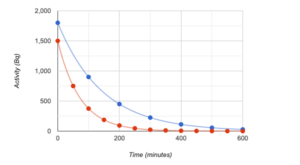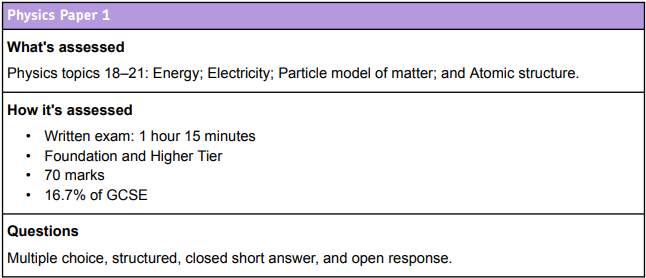Mock test. 70 marks available.
GCSE AQA Combined Science Trilogy Physics Paper 1
Good Luck!
Quiz Summary
0 of 37 Questions completed
Questions:
Information
You have already completed the quiz before. Hence you can not start it again.
Quiz is loading…
You must sign in or sign up to start the quiz.
You must first complete the following:
Results
Results
0 of 37 Questions answered correctly
Your time:
Time has elapsed
You have reached 0 of 0 point(s), (0)
Earned Point(s): 0 of 0, (0)
0 Essay(s) Pending (Possible Point(s): 0)
| Average score |
|
| Your score |
|
Categories
- Not categorized 0%
- 6 Mark Questions 0%
- 1
- 2
- 3
- 4
- 5
- 6
- 7
- 8
- 9
- 10
- 11
- 12
- 13
- 14
- 15
- 16
- 17
- 18
- 19
- 20
- 21
- 22
- 23
- 24
- 25
- 26
- 27
- 28
- 29
- 30
- 31
- 32
- 33
- 34
- 35
- 36
- 37
- Current
- Review
- Answered
- Correct
- Incorrect
-
Question 1 of 37
1. Question
2 point(s)[question number = 01.1] Use one of the following numbers to fill in the blank:
110, 12, 24, 230-
Complete the sentence: In the UK the domestic electricity supply has a frequency of Hz and is about V.
Correct 2 / 2 PointsIncorrect / 2 Points -
-
Question 2 of 37
2. Question
2 point(s)[question number = 01.2] Use one of the following numbers to fill in the blank:
Batteries, mains power, does, does not
-
Complete the sentence: Direct current is supplied by and charge change direction.
Correct 2 / 2 PointsIncorrect / 2 Points -
-
Question 3 of 37
3. Question
3 point(s)[question number = 01.3] A wire carries 15 A of current at 120 V. Calculate:
a) The power in watts
b) The resistance in ohms
c) The current that would flow if the voltage doubled but resistance stayed the same-
- watts
- ohms
- amperes
CorrectIncorrect -
-
Question 4 of 37
4. Question
3 point(s)[question number = 01.4] Drag and drop to match the purpose with the correct wire
Sort elements
- Live
- Earth
- Neutral
- Connects the appliance to the power supply
- Provides an alternative (low resistance) path for the current in the case of a fault
- Provides a return path to the power supply from the appliance
CorrectIncorrect -
Question 5 of 37
5. Question
6 point(s)[question number = 01.5] Students are told that they should investigate how the resistance of a wire changes with its length.
Plan an investigation to determine the relationship between the length of a wire and its resistance. (enter your answer)
You should include:
- how to set up the apparatus and the materials you would use:
- how to collect and record data
- how to ensure accuracy and reliability of results.
Correct 6 / 6 PointsIncorrect / 6 Points -
Question 6 of 37
6. Question
3 point(s)[question number = 02.1] Drag and drop to match the disadvantages to the correct energy resource
Sort elements
- Fossil fuels
- Wind and solar energy
- Tidal energy
- Produce greenhouse gases
- Intermittency
- Salt water is corrosive
CorrectIncorrect -
Question 7 of 37
7. Question
1 point(s)[question number = 02.2] Which of the following are fossil fuels?
CorrectIncorrect -
Question 8 of 37
8. Question
1 point(s)[question number = 03.1] Convert 0.0000789 to standard form
- x 10
CorrectIncorrect -
-
Question 9 of 37
9. Question
1 point(s)[question number = 03.2] Convert 236,000 into standard form
- x 10
CorrectIncorrect -
-
Question 10 of 37
10. Question
1 point(s)[question number = 03.3] Convert 2400μm to m
-
m
CorrectIncorrect -
-
Question 11 of 37
11. Question
1 point(s)[question number = 03.4] Convert 32,400 s to hours
-
H
CorrectIncorrect -
-
Question 12 of 37
12. Question
1 point(s)[question number = 03.5] A square metal plate has sides of length 2.54 × 10⁵ micrometres. Calculate the perimeter of the plate in metres, give your answer in ordinary form to three decimal places.
-
m
CorrectIncorrect -
-
Question 13 of 37
13. Question
1 point(s)[question number = 04.1] Calculate the change in momentum of an object that experiences a force of 350 N over 15 s.

-
kg m/s
CorrectIncorrect -
-
Question 14 of 37
14. Question
1 point(s)[question number = 04.2] Calculate the distance moved when a 650 J of work is done to move a 160 N object. Leave your answer to 1 d.p.
-
m
CorrectIncorrect -
-
Question 15 of 37
15. Question
1 point(s)[question number = 04.3] Jack moves a cube weighing 250N. He moves the cube by 2.5m in a straight line. Calculate the work done by Jack.
-
J
CorrectIncorrect -
-
Question 16 of 37
16. Question
1 point(s)[question number = 05.1] A train is travelling at 45 miles per hour. The driver puts on the brakes in order to stop at the station. Where is the kinetic energy of the train being transferred to?
CorrectIncorrect -
Question 17 of 37
17. Question
2 point(s)[question number = 05.2] Energy can be transferred to useful and non-useful forms. Which of the following are non-useful transfers of energy?
CorrectIncorrect -
Question 18 of 37
18. Question
1 point(s)[question number = 05.3] How can you reduce the effect of friction in the chain on a bicycle?
CorrectIncorrect -
Question 19 of 37
19. Question
1 point(s)[question number = 05.4] What are the units we use for measuring energy?
CorrectIncorrect -
Question 20 of 37
20. Question
1 point(s)[question number = 05.5] What do we use to slow the rate of heat loss out of a house?
CorrectIncorrect -
Question 21 of 37
21. Question
1 point(s)[question number = 05.6] Which process transfers heat using electromagnetic waves?
CorrectIncorrect -
Question 22 of 37
22. Question
1 point(s)[question number = 05.7] Using the kinetic energy equation – calculate the kinetic energy of a car with a mass of 1200kg travelling at 10 m/s.
-
J
CorrectIncorrectHint
If you do not remember the kinetic energy equation visit the link above the quiz
-
-
Question 23 of 37
23. Question
1 point(s)[question number = 05.8] How is gravitational potential energy stored?
CorrectIncorrect -
Question 24 of 37
24. Question
1 point(s)[question number = 05.9] An object with a mass of 5kg is 100m above the ground and has 35 J of gravitational potential energy. What will happen to the gravitational potential energy if the mass was increased to 10kg?
CorrectIncorrect -
Question 25 of 37
25. Question
3 point(s)[question number = 06.1] Drag and drop to match the description to the type of particle
Sort elements
- Ions
- Alpha particle
- Beta particle
- Atoms which have gained or lost electrons
- A helium nucleus – two protons and two neutrons
- An electron
CorrectIncorrect -
Question 26 of 37
26. Question
1 point(s)[question number = 06.2] Which material do we commonly use to line the containers where radioactive sources are stored?
CorrectIncorrect -
Question 27 of 37
27. Question
1 point(s)[question number = 06.3] The half-life of cobalt-60 is 5 years. If there are 100g of cobalt-60 in a sample, how much will be left after 15 years?
CorrectIncorrect -
Question 28 of 37
28. Question
1 point(s)[question number = 06.4] The graph shows the activity of two different radioactive substances. Determine the half-life of Source B (red) in minutes.

-
minutes
CorrectIncorrect -
-
Question 29 of 37
29. Question
1 point(s)[question number = 06.5] Put the types of radiation in order from most ionising to least ionising.
- Beta particles
- Alpha particles
- Gamma rays
View Answers:
CorrectIncorrect -
-
Question 30 of 37
30. Question
1 point(s)[question number = 06.6] The graph shows the activity of two different radioactive substances. Determine the half-life of Source A (blue) in minutes. Do not add the units.

-
minutes
CorrectIncorrect -
-
Question 31 of 37
31. Question
1 point(s)[question number = 07.1] Calculate the specific latent heat of vaporisation/evaporation for carbon dioxide using the following information. You have a 1.5kg sample of carbon dioxide that changed state from a liquid to a gas. The energy required to evaporate it was 856.62 J
-
J/kg
CorrectIncorrect -
-
Question 32 of 37
32. Question
5 point(s)[question number = 07.2] Use some of the following words to complete the definition.
Specific, cool, leftover, latent, power, energy, 1, 100, 1000, mixture, state
-
Complete the definition:
- Specific describes the amount of it takes to make kg of a substance change .
CorrectIncorrect -
-
Question 33 of 37
33. Question
6 point(s)[question number = 07.3] Match the change of state with the transition using the words below.
Freezing, sublimation, evaporation or boiling, condensation, melting, deposition
-
- Gas to liquid =
- Liquid to solid =
- Solid to liquid =
- Liquid to gas =
- Solid to gas =
- Gas to solid =
CorrectIncorrect -
-
Question 34 of 37
34. Question
1 point(s)[question number = 07.4] Calculate the mass of a block of platinum when the change in thermal energy is 50 J, the specific heat capacity is 0.12 J/kg °C, and the change in temperature is 10 °C.
-
Kg
CorrectIncorrect -
-
Question 35 of 37
35. Question
3 point(s)[question number = 08.1] A metal cube has a mass of 648g and each side is 6 cm long. Calculate: a) The volume in m³ b) The density in kg/m³ c) The mass in kg of a second cube of the same material with 0.03 m sides
-
- m³
- kg/m³
- kg
CorrectIncorrect -
-
Question 36 of 37
36. Question
3 point(s)[question number = 08.2] An engineer wants to build a cube 5 times larger than the original cube (6 cm sides) using identical small metal cubes of the same size as the original. Calculate:
a) How many of the original-sized cubes would be needed to complete this larger cube?
b) What would be the total mass of this larger cube?
c) What would be the volume of the new cube?
-
- cubes
- kg
- m³
CorrectIncorrect -
-
Question 37 of 37
37. Question
5 point(s)[question number = 08.3] 2000 of the 5 times larger metal cubes (30 cm sides) need to be transported to a construction site within 3 days. A standard lorry flatbed has dimensions of 13.6 m length × 2.55 m width, with a maximum permitted height of 4.9 m. The maximum payload (carrying capacity) of each lorry is 28,000 kg. Calculate:
a) How many cubes can fit along the length and width of the flatbed? (Ignore height for now)
b) If these cubes can be stacked, how many layers high can they go within the legal height limit?
c) What is the total number of cubes that could be transported in one journey?
d) Given each cube weighs 81 kg, what is the actual maximum number of cubes that can be transported per journey due to the weight limit?
e) How many lorry journeys will be required?
-
- cubes
- layers
- cubes
- cubes per journey
- journeys
CorrectIncorrect -
Is this higher or foundation?
This is a combined paper for higher and foundation students. You can achieve grades 1 – 9 on this paper, so it is suitable for all. Grades are moderated against the average result to give the most accurate indication of your performance. You can look at – How is this paper marked? for more information.
How is this paper marked?
This paper is automatically marked to determine which questions were answered correctly.
Your grade is determined using a Z-Score moderation system. Your GCSE exams are also moderated comparably so that the difficulty of papers is taken into account.
Roughly, this works by calculating your overall percentage and comparing it to the average percentage and the standard deviation. This means that for harder papers you need fewer points to get the same grade as you would for an easier paper.
As more students attempt the paper, the average score and standard deviation more accurately represent the difficulty of the paper and the grades become more accurate.
Making these papers and the marking system took considerable effort so if you found them helpful for your revision, please show your appreciation by rating the page.
Related Quizzes
Which exam board are you studying?



